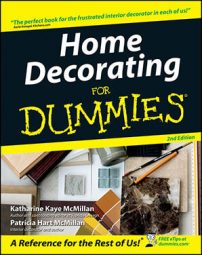Decorating your kitchen should be fun. Collect photographs from decorating magazines, brochures, and kitchen style books. Make a list of your likes (and dislikes) about photos. By mixing a little of one and a lot of another, you craft your own personal style.
Here are some basic decorating tips:
Use contrast: Cabinets star against a background chosen to show them off. The key is contrast. For fancy cabinets, backgrounds (walls, floors, and ceilings) should be plainer. Choose a simple paint, paneling, or a small-patterned wallcovering for walls. Paint the ceiling in a light color that coordinates with the cabinets. Flooring should be a darker value than the walls, but shouldn’t be too colorful or patterned.
If you want cabinets to recede into a unified background, reduce the contrast. Keep cabinets and wall, floor, and ceiling treatments related. The less contrast you use, the quieter and more serene your room. A calm background paves the way for something else to become the focal point.
Don’t overlook your kitchen’s ceiling: Most ceilings get short shrift in decorating. Kitchens are great places for beams, coffers, beautiful paint colors, wall coverings, stenciling, and trellises. The larger the kitchen, the more obvious the ceiling and the more it demands that some visual interest be added.
Make the stove hood a focal point: In kitchens today, the hood is the design prima donna. Hanging on carved corbels (supporting brackets) above a fully integrated backsplash and stove, the hood becomes a focal point. Consider creating your own focal point in any number of styles.
Underneath this show horse is a workhorse: the ducted ventilation fan. Make sure you have the right number of CFMs (cubic feet of air moved per second) to clear your kitchen of cooking odors. You can plan to spend a thousand or more dollars for a large, truly decorative hood (in addition to the cost of the fan).
Use fabrics and furniture: If your kitchen incorporates a seating area, decide whether you want your furniture fabrics to play a starring role or second fiddle to an exotic floor or wall pattern. If upholstery’s the star, patterns can be as big and bold as suitable scale allows. If your upholstery plays second fiddle, choose a pattern that’s on the small side (such as a small woven check, plaid, or stripe). Coordinate seating-area fabrics with fabrics on kitchen chairs. Make fabric chair pads or cushions in coordinating patterns, colors, and texture.
Choose easily upholstery and fabrics that are easy to clean. Consider using washable slipcovers over any upholstery.
Streamline window treatments: The kitchen is one place where a handsome window with no treatment at all is most desirable. In most cases, less is better unless your style calls for dressy draperies, especially in an upholstered seating area. Thick-slat blinds, wooden shutters, matchstick and old-fashioned window blinds are great simple solutions to providing light control and privacy. But dozens of alternative-style draperies, curtains, swags, and jabots (arrangements of looped material) are available.
Add eye appeal: Larger kitchens make room for china cabinets, bookshelves, and displays of favorite family photographs, antique plate collections, pitchers, a clutch of colored candlesticks, and more. Arrange your collectibles on open shelves with care; the better the items relate to one another and to the space, the more attractive they look.
Almost anything used in the kitchen can double as an accessory, especially when you’ve got a collection of items, such as wooden bowls, spoons, or rolling pins, interesting pottery or porcelain, colorful trays, woven baskets, old painted tins, cookie cutters, copper pots, and tole ware.

